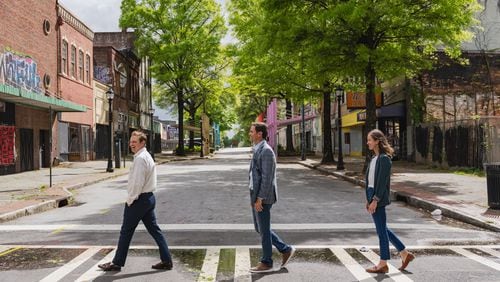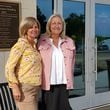Robinson and his Physician Assistant Kelly Futral are on staff at Northside Hospital in Atlanta and Forsyth, and at Piedmont Hospital Atlanta. They treat patients in their in-town Atlanta office as well as a north metro office on the campus of Northside Forsyth Hospital. If you're a physician or allied health professional seeking a patient consultation, please contact Robinson at info@brainexpert.com or 404-254-3160.
Dorothy Anning could see the fear on people's faces.
They saw her and shuddered. Others turned their heads. Some even ran away.
Her right eye was several inches lower than where it should have been, forced out of the socket by a tumor that had grown from the skull. It occupied the space where her eye should have been.
While her deformity rarely caused her pain, adults and other children in her home country of Ghana often viewed her with shock and fear.
"I wasn't experiencing any pain," Anning said. "The only thing I was getting was rejection. People were scared of me. Once they would see me they would start running."
When she was only 6, Anning developed a cranial tumor that grew from the bone in her skull and protruded out behind the right half of her face. As she grew, the tumor grew with her, causing her right eye to sit inches lower than her left as the tumor occupied most of her eye socket, pushing the eye completely out.
For years, Anning's parents took her to doctors in South Africa and even Europe to try to determine how to operate on the tumor, but they were unsuccessful. Then one of the Ghanaian doctors, leading ophthalmologist Dr. Boateng Wiafe, contacted Children's Cross Connection International (CCCI). The Atlanta-based organization works to meet the medical, educational and daily living needs of children in third-world countries.
CCCI founder Pam Rundle decided to secure Anning's medical care, cover travel expenses, and find a host family in America so that Anning could receive the medical attention she needed.
"Dorothy was such an unusual case and obviously she needed assistance and needed it right away," Rundle said.
In April 2008, Anning, then 14, headed to America for her tumor operation.
A medical mystery
Dr. Jim Robinson, a board-certified physician and nationally recognized neurosurgeon, had never seen a case as severe as Anning's tumor. When Rundle contacted him about Anning, he could not immediately identify her condition, but he was intrigued and interested in helping the young woman.
The condition was not just a cosmetic deformity, but life-threatening for the student known as one of the brightest in her class, he said.
"You can see how deep it goes inside of her head and the shift and pressure in the brain. There is a cosmetic component to it, but here she's been having this growing for years leading up to this, visible, and getting bigger and bigger," he said. "She was tough as nails. She was absolutely sweet, too."
Robinson took a limited biopsy and asked colleagues during a meeting of the American Association of Neurosurgeons to review her films and medical information. They agreed that it was an unusual case, and most of the national experts he shared the case with had never seen anything like it. Robinson was compelled to solve the medical mystery and assist Anning.
He said he decided, "I am willing to take it on and will do the best that I can for Dorothy."
Robinson conducted extensive research and asked numerous brain surgeons for their opinions. One neurosurgeon, Ossama Al-Mefty, told him he believed it was a case of cystic fibrous dysplasia. The extremely rare type of brain tumor affects the bone in the skull and often leads to the compression of optic nerve. This type of tumor cannot be effectively treated with radiation because it has a 50-50 chance of becoming malignant if radiation is applied.
Robinson's only choice was to remove the entire tumor without any residual, in order to effect a cure.
The day before her surgery, Robinson and his family took Anning sightseeing in Atlanta to calm her nerves. At the Georgia Aquarium, Anning remembers seeing whales for the first time. She still has the souvenir stuffed penguin.
"It took my mind off of all of the pressure because I was so scared," said Anning.
Anning's surgery took over 23 hours over two days of surgery with a rest day for Robinson and Anning in between. Robinson worked patiently and tirelessly to remove the tumor. He describes the procedure as a craniofacial resection of a tumor because the surgery required him to work in the skull and face. He had to be willing to work "freestyle" in a risky situation, removing the tumor away from the brain and from the blood vessels and delicate important nerves at the greatest depths of the mass.
Once Anning recovered from the removal, Robinson performed a reconstruction of the missing skull and upper eye socket. He enlisted Dr. Farzad Nahai, a craniofacial plastic surgeon to help reconstruct the lower eye socket. The prosthesis to replace the bone was made through 3D printing from a computerized model of what the final result would look like. Robinson was amazed that the displaced eye had sight at 20/200 when he first saw Anning. A week after removal of the mass, the eye already had recovered to 20/40 vision.
"For me, for people to entrust their lives to me, to get to do what I get to do for them, having that privilege is just overwhelming sometimes." Robinson said.
Risks also included the possibility of an infection, which never occurred. After about a month and a half of recovery, Anning and her mother, Comfort, returned home to Ghana. Anning’s reconstructed face also gave her a new outlook on life. Her fear of being rejected by her peers had dissipated.
"I was so happy," said Anning. "When I was walking, I would have to bend my head because if I raised my head they would start running. For the first time I realized that I could just walk with my head up high."
Impacting lives worldwide
Anning's one-of-a-kind surgery is a milestone in Robinson's 25-plus year medical career. Hers is one of the most dramatic of its kind in the world medical literature, he said.
He graduated Magna Cum Laude from the Medical College of Pennsylvania in Philadelphia in 1990 and completed a surgical internship, neurosurgical residency and fellowship in epilepsy surgery at the renowned Bowman Gray School of Medicine at Wake Forest University. In addition, he holds an MBA from Emory University.
"(It was) an extremely rare case and hugely impactful for Dorothy, who is such a great young woman. You put all of that together, and that would be my greatest accomplishment as a surgeon," he said.
Yet Anning's complicated case reflects the nature of Robinson's work. Robinson welcomes each new challenge as a chance to help a patient in need, and he's performed surgeries on patients from Europe, Africa, South and Central America, and North America.
Robinson's skill as a surgeon combines with his desire to help individuals in countries who may not have access to quality care they need. In addition to treating patients from around the southeastern U.S. and bringing charity cases to Atlanta for surgery, he travels doing medical mission work in Honduras, Nicaragua, El Salvador and the Dominican Republic.
Robinson, who served as medical director of the Piedmont Gamma Knife Center, also helped to create a Gamma Knife Radiosurgery center in the Dominican Republic, and trained the physicians there in the procedure. There was no known center for brain tumors like that in the country previously, and the center has now treated over 450 patients to date.
“To me, for a long time it had been a great social injustice that the only people in developing countries that can have that kind of care (Gamma Knife Radiosurgery) are people that are so wealthy that they can come to United States, and pay what is essentially the equivalent of 10 years of salary for an average person in their country," said Robinson.
Having built a large general neurosurgery practice previously in which most of the doctors focused on spinal surgery, Robinson decided to start a highly specialized practice in his specialty of cranial neurosurgery, laser-focused on providing the best possible care to his patients. He has also served as chief of neurosurgery and chairman of the neurosciences department at Piedmont Hospital.
Robinson's new practice focuses on afflictions of the brain, such as brain, pituitary and base of skull tumors and trigeminal neuralgia (a debilitating facial pain syndrome). Robinson's reputation for consistently exceptional work is backed up with patient outcomes, such as dramatically low mortality, a return to normal activities, a short hospital stay and low readmission rates.
"What I feel the best about in terms of professional accomplishment is maintaining focus on where I am and what I am doing with patients all of the time," said Robinson. "The best athletes are not the ones who can make that one incredible shot, they are the people who execute consistently on what they do all of the time."
Years have passed but Robinson and Anning still keep in touch frequently, often communicating via WhatsApp. Anning is now 21 years old and attending a physician assistant (PA) school at the university in Ghana. Robinson remembers how Anning told him, at their first meeting, that she wanted to work in the medical field. Now he is contributing to her tuition so she can achieve that dream.
Anning says she wants to use her experience as a patient to help others with deformities and medical conditions.
"Most of the other doctors thought it was a burden because my case was so complicated," said Anning. "[Robinson] just opened up and said, 'I can do it, I will do it.' I am just so thankful to him."


/cloudfront-us-east-1.images.arcpublishing.com/ajc/P7DYBH6TO7FEKG4SUXQQKADRXE.jpg)


